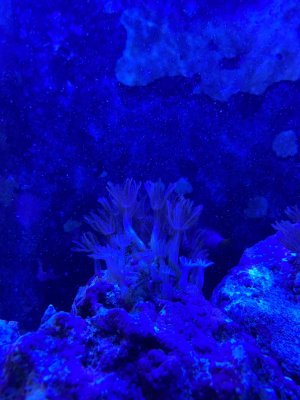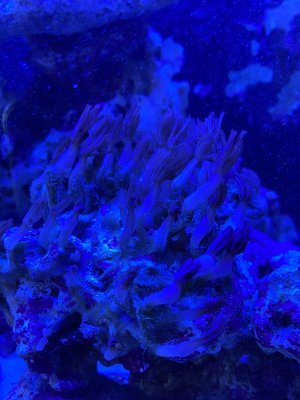Navigation
Install the app
How to install the app on iOS
Follow along with the video below to see how to install our site as a web app on your home screen.

Note: This feature currently requires accessing the site using the built-in Safari browser.
More options
You are using an out of date browser. It may not display this or other websites correctly.
You should upgrade or use an alternative browser.
You should upgrade or use an alternative browser.
Xenia help
- Thread starter JustPoprocks
- Start date
fishguy242
Cronies
- Review score
- +0 /0 /-0
R2R Supporter
Hospitality Award
Midwest Reefer
Fish Medic
R2R Secret Santa 2022
Build Thread Contributor
hi is it poss clove polyps
ScottR
Surfing....
- Review score
- +0 /0 /-0
R2R Supporter
R2R Excellence Award
Reef Squad Emeritus
Hospitality Award
Hong Kong Reef Club
Build Thread Contributor
Not sure what you’re asking based on pic. Can you be more specific with a clearer pic? Definitely a xenia though.
Sorry, so most Xenia I’ve seen is like one thick base with a bunch of polyps, mine is just a ton of thin 1”-2” stalks with one polyp.Not sure what you’re asking based on pic. Can you be more specific with a clearer pic? Definitely a xenia though.
ScottR
Surfing....
- Review score
- +0 /0 /-0
R2R Supporter
R2R Excellence Award
Reef Squad Emeritus
Hospitality Award
Hong Kong Reef Club
Build Thread Contributor
So yours doesn’t have a thick base? I see lots of polyps in that pic you posted.Sorry, so most Xenia I’ve seen is like one thick base with a bunch of polyps, mine is just a ton of thin 1”-2” stalks with one polyp.
So yours doesn’t have a thick base? I see lots of polyps in that pic you posted.
this is a stock photo but see how they have one thick base and many plops but mine spread on the rock. I mean my have grown 150+ new polyps all the same base.
OrionN
Anemones
- Review score
- +0 /0 /-0
Reef Squad
R2R Supporter
R2R Excellence Award
Photo of the Month
Article Contributor
Build Thread Contributor
- Joined
- Jul 28, 2013
- Messages
- 7,572
- Reaction score
- 17,602
- Review score
- +0 /0 /-0
- Location
- Corpus Christi, TX
You don't have Xenia, but a colony of star polyp. Xenia pulses, your's star polyps do not.
Also knows as clover star polyps, a soft coral in the Genus of Clavularia.
Also knows as clover star polyps, a soft coral in the Genus of Clavularia.
Last edited:
The base will thicken up
OrionN
Anemones
- Review score
- +0 /0 /-0
Reef Squad
R2R Supporter
R2R Excellence Award
Photo of the Month
Article Contributor
Build Thread Contributor
- Joined
- Jul 28, 2013
- Messages
- 7,572
- Reaction score
- 17,602
- Review score
- +0 /0 /-0
- Location
- Corpus Christi, TX
You notice the key different, Xenia have one trunk with multiple heads while Anthelia have single head per stalk. Anthelia move with water movement, not pulsing like Xenia. Some of the Anthelia have polyps very similar to Xenia, while others looks more like green star polyps (Pachyclavularia sp).Really think so? The polyps look almost exactly like pom pom
Sorry for the bad quality
View attachment 1415087
vetteguy53081
Well known Member and monster tank lover
- Review score
- +12 /0 /-0
Partner Member 2023
R2R Supporter
R2R Excellence Award
Reef Tank 365
Article Contributor
Tampa Bay Reef Keepers
West Palm Beach Reefer
Hospitality Award
Ocala Reef Club Member
305 Reef Club
Wisco Reefers
Midwest Reefer
Fish Medic
MAC of SW Florida
R2R Secret Santa 2022
White Pom Pom Xenia
Bryce M.
Valuable Member
- Review score
- +0 /0 /-0
R2R Secret Santa 2022
Build Thread Contributor
That's def xenia, star polyps don't look or act like that. mine form a thin skin on the rock
OrionN
Anemones
- Review score
- +0 /0 /-0
Reef Squad
R2R Supporter
R2R Excellence Award
Photo of the Month
Article Contributor
Build Thread Contributor
- Joined
- Jul 28, 2013
- Messages
- 7,572
- Reaction score
- 17,602
- Review score
- +0 /0 /-0
- Location
- Corpus Christi, TX
OP,
Anthelia, somebody has for sale on this thread, I think the same as your coral
Here is one of the picture on this thread

Video of Xenia coral
Anthelia, somebody has for sale on this thread, I think the same as your coral
Video of Xenia coral
OrionN
Anemones
- Review score
- +0 /0 /-0
Reef Squad
R2R Supporter
R2R Excellence Award
Photo of the Month
Article Contributor
Build Thread Contributor
- Joined
- Jul 28, 2013
- Messages
- 7,572
- Reaction score
- 17,602
- Review score
- +0 /0 /-0
- Location
- Corpus Christi, TX
@Bryce M.That's def xenia, star polyps don't look or act like that. mine form a thin skin on the rock
Your coral sound like a Clavularia sp. They grow in mats with polyps extended from there. The problem with common name is that these Genus (Xenia, Anthelia, Clavularia) and Heteroxenia all have somewhat of the same common name, depends on who calling them.
If anybody interested about finding the differences about these corals, all they have to do is search and read about them.
The OP's coral is definitely a coral in the Anthelia genus. I am not certain on the exact species. There are a numbers of species in each of the 4 Genus mention above. I am not good enough to ID them to the species level other than Xenia elongata.
Anthelia can retract their polyp completely into it's stalk if disturbed. Clavularia can partly retracted and formed into a little ball at the end of the stalk, while Xenia cannot retract their polyps at all, only curled up when disturbed. Heteroxenia have dimorphic, two types of polyps, thus named Heteroxenia.
Julian Sprung's book: "CORALS A Quick Reference Guide" published in 1999 mention these corals. Does not give a lot of information. However, quick search on the internet will give information on these Genus of corals in detail.
Last edited:
ScottR
Surfing....
- Review score
- +0 /0 /-0
R2R Supporter
R2R Excellence Award
Reef Squad Emeritus
Hospitality Award
Hong Kong Reef Club
Build Thread Contributor
I recall reading that these corals have been reclassified many times and some people still call them by the improper name i.e. xenia when it is no longer classified as such. You’re right though, it is anthelia. And many people also refer to them incorrectly as xenia.@Bryce M.
Your coral sound like a Clavularia sp. They grow in mats with polyps extended from there. The problem with common name is that these Genus (Xenia, Anthelia, Clavularia) and Heteroxenia all have somewhat of the same common name, depends on who calling them.
If anybody interested about finding the differences about these corals, all they have to do is search and read about them.
The OP's coral is definitely a coral in the Anthelia genus. I am not certain on the exact species. There are a numbers of species in each of the 4 Genus mention above. I am not good enough to ID them to the species level other than Xenia elongata.
Anthelia can retract their polyp completely into it's stalk if disturbed. Clavularia can partly retracted and formed into a little ball at the end of the stalk, while Xenia cannot retract their polyps at all, only curled up when disturbed. Heteroxenia have dimorphic, two types of polyps, thus named Heteroxenia.
Julian Sprung's book: "CORALS A Quick Reference Guide" published in 1999 mention these corals. Does ot give a lot of information. However, quick search on the internet will give information on these Genus of corals in detail.
Bryce M.
Valuable Member
- Review score
- +0 /0 /-0
R2R Secret Santa 2022
Build Thread Contributor
oh interesting, I post to educate and learn@Bryce M.
Your coral sound like a Clavularia sp. They grow in mats with polyps extended from there. The problem with common name is that these Genus (Xenia, Anthelia, Clavularia) and Heteroxenia all have somewhat of the same common name, depends on who calling them.
If anybody interested about finding the differences about these corals, all they have to do is search and read about them.
The OP's coral is definitely a coral in the Anthelia genus. I am not certain on the exact species. There are a numbers of species in each of the 4 Genus mention above. I am not good enough to ID them to the species level other than Xenia elongata.
Anthelia can retract their polyp completely into it's stalk if disturbed. Clavularia can partly retracted and formed into a little ball at the end of the stalk, while Xenia cannot retract their polyps at all, only curled up when disturbed. Heteroxenia have dimorphic, two types of polyps, thus named Heteroxenia.
Julian Sprung's book: "CORALS A Quick Reference Guide" published in 1999 mention these corals. Does not give a lot of information. However, quick search on the internet will give information on these Genus of corals in detail.
Similar threads
- Replies
- 2
- Views
- 149
- Replies
- 8
- Views
- 495




















